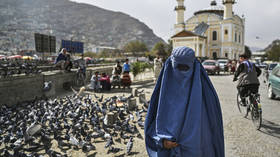Who's really to blame for Europe's new migrant crisis?
Migration is now Europe’s hot-button issue amid a spike in desperate migrants trying to cross the Polish-Belarusian border. Belarus has had an obvious role in creating the crisis, but the root causes started long before that.
Over the past week, the news cycle has been dominated by stories from the EU’s eastern frontier, after reports began emerging of several thousand refugees and migrants attempting to breach the barbed-wire fences set up by Polish authorities.
Warsaw has deployed some 12,000 troops, with the humanitarian crisis quickly escalating into a military standoff. Donald Tusk, the former president of the European Council, has suggested that the country should consider triggering NATO’s Article 4, which would mean Warsaw indicating to the US-led bloc that its security is threatened. Polish Defense Minister Mariusz Błaszczak said last Friday that troops from NATO member Britain are set to be deployed in Poland to aid in the construction of barriers.
The Belarusian government, for its part, has been accused of flying in migrants on tourist visas and escorting them directly to the Polish border. Since the news broke, a number of airlines have suspended flights to Minsk. Belarusian guards have also allegedly prevented migrants from turning back from the border, leaving many stuck in the wilderness, and a number of people are alleged to have died in the icy conditions. Minsk said on Friday that some 2,000 migrants have been flown back to their countries after border tensions came to a head.
In a fanciful but unsurprising turn, Polish PM Mateusz Morawiecki injected some tried-and-tested Russiagate-mania into the whole affair when he made the unsubstantiated accusation that Russia is instigating the crisis. During a speech on Tuesday, he alleged that embattled Belarusian leader Alexander Lukashenko’s “enabler” is Russian President Vladimir Putin, “which shows a determination to carry out the scenario of rebuilding the Russian empire, that all Poles have to forcefully oppose.” Russia has denied any involvement, and a split is opening up between the two countries as Lukashenko’s antics become more and more extreme.
The far right government in Warsaw’s militarization of the border and Minsk’s role in turning migrants into strategic pawns paint a cynical view of the whole situation. Both countries are accused of pushing migrants back and forth across the border, violating international law and leaving desperate people trapped between the two jurisdictions. With each side now bearing some responsibility in letting the crisis reach this point, perhaps what is called for is a reflection on how we got here.
Europe’s ‘migrant threat’
In 2015 and 2016, Turkish President Recep Tayyip Erdogan held Europe hostage over the large number of migrants making their way toward the continent, stating unequivocally that “[Turkey] can open the doors to Greece and Bulgaria” according to leaked communications between Erdogan and EU leaders at the time.
The EU eventually signed a refugee agreement with Turkey to share the burden of the Syrian ‘exodus’, paying Turkey billions for taking back and housing migrants that would otherwise continue traveling north.
Minsk is following the example set by Ankara, putting pressure on the EU with the hope that it’ll make similar concessions. The EU is aware of this strategic calculus, with many insisting that the migrants are part of a ‘hybrid attack’ engineered by Belarus.
EU leaders are now reportedly drafting a proposal condemning “any attempt by third countries to instrumentalize migrants for political purposes,” noting that the bloc will “respond accordingly” to “recent hybrid attacks at the EU’s borders.” EU Commission President Ursula von der Leyen previously invoked the term “hybrid attack” when she accused Belarus of sending migrants toward the EU to “destabilize Europe.”
Such language seems at odds with the moralizing humanitarianism of ‘refugees are welcome here’ that was en vogue around 2015. Whereas back then Poland drew the ire of Eurocrats for limiting its intake of migrants, this time around the EU appears largely on board with Poland and others enforcing their sovereign borders, even if it means hanging migrants out to dry.
The EU can’t decide whether migrants pose a threat. If they don’t, as some have suggested, then there is no migrant crisis at the Polish-Belarusian border, and the situation is easily diffused by letting the migrants into the bloc.
As it were, however, real and potential waves of migration into Europe, whether as big as in 2015 or as relatively small as today, are treated as destabilizing, which is why Minsk’s antics have been able to cause such an uproar.
Part of the reasoning behind the EU’s hesitancy to let in the migrants standing at Poland’s border is a desire to rebuff future waves of migration. If the EU admits a couple of thousand, what’s to stop more from using Belarus as a transit point later on? Still, discouraging people from migrating does nothing to address the factors that compel someone to migrate in the first place.
The EU’s vulnerability with respect to migrants goes beyond states like Belarus and Turkey cynically exploiting it. The ultimate cause can be traced back to the activities of Brussels' biggest ‘ally’.
America’s war on stability
The common denominator between some of the most prevalent migrant-origin countries, namely Syria, Afghanistan, and Iraq, is that these states have been the targets of American interventionism over the past 20 years.
According to a 2020 report by the Costs of War project, at least 37 million people have been forcibly displaced by America’s post-9/11 wars. The list of countries includes the three previously mentioned, as well as Yemen, Somalia, Libya, and others. The report gives 37 million as a “conservative estimate,” stating that the actual total “could be closer to 48–59 million.”
In August, while the US was in the midst of a graceless withdrawal from Afghanistan, some in Europe warned that a new refugee wave would be soon to follow, a view spawned by early reports of Afghans trekking westward via Iran.
Though America is slowly and reluctantly abandoning its regime-change projects in the Middle East, including Afghanistan, it has left behind an enduring legacy of instability, poverty, and war. These ‘push factors’ will keep migration relevant for years to come. With their home countries in ruins, Middle Eastern refugees will continue to seek out ways to reach Europe.
The US has taken in some of the refugees, however Europe’s proximity to the Middle East means it is far less insulated from disturbances to regional stability, as was made abundantly clear during the early years of the Syrian dirty war and the ensuing migrant crisis in 2015.
In Syria, the US is still actively engaged in exacerbating the conflict and preventing reconstruction. Sanctions under the far-reaching CAESAR Act make the lives of Syrians exceedingly difficult, all the while SDF forces backed by American troops continue to occupy roughly one third of the country.
On the diplomatic front, too, the US has tried to prevent Syrian stabilization. The foreign ministers of the UAE and Egypt recently made statements indicating that Syria could be brought back into the fold of Arab countries, prompting backlash from US State Department spokesman Ned Price and a ranking member of the Senate Foreign Relations Committee.
The stickiness of the present situation at the Polish-Belarusian border risks obscuring these underlying facts. A way out of the immediate crisis may just be for Warsaw to draw down its troops and for Belarus to repatriate the migrants, at least those who came on tourist visas and/or are ineligible for asylum in the European Union. Long-term, however, much more is needed. Russian Foreign Minister Sergey Lavrov put it plainly, saying that “the main responsibility for resolving the migrant crisis lies with those who made it possible for the crisis to start in the first place.”
Like this story? Share it with a friend!
The statements, views and opinions expressed in this column are solely those of the author and do not necessarily represent those of RT.
The statements, views and opinions expressed in this column are solely those of the author and do not necessarily represent those of RT.














